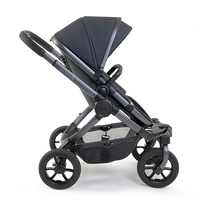

Tackling Fussy Eating in Toddlers by Lucey Barclay & Victoria Rose
I’m Lucey Barclay, I have two children called Charlie and Sienna and I live in Muswell Hill with my husband, chef Miguel Barclay.
At certain times of the day (three times a day to be precise) I cannot deny that my heart sinks a little bit. It’s time to feed my eight-month year old baby, and it’s often quite a challenge...
Weaning my second baby has been surprisingly trickier than my first, and it caught me a bit by surprise. Although Sienna seems hungrier, in that she eats more often and in larger amounts, she is far fussier and prone to be a bit of a food refuser. To be fair, she knows what she likes and she’s not for budging (which I secretly love) and she is the cutest baby in the world, which helps tremendously.
Charlie ate most foods as long as they were blended, but Sienna is much pickier and (unlike me) has very little time for the more savoury things in life.
She has a decent appetite for sweet food – most fruit-based foods are a winner - however when it comes to anything savoury, she simply purses her beautiful little mouth shut and stares at me defiantly. This means feeding time can take upwards of 40 minutes per meal.
If, like me you are struggling with a fussy eater have a look at these incredible ‘Top ‘Tips’ from Antenatal Educator, Sleep Coach and Weaning Specialist Victoria Rose from Allaboutbabies.

Top Six Tips for Tackling Fussy Eating in Toddlers
1. When introducing solids consider a ‘Baby-Led Weaning’ approach. Research has shown that babies who are introduced to solids from 6 months with a BLW approach, eating foods in their real form, learning what they look, feel and taste like by exploration and self-feeding are growing up into toddlers who aren’t described by parents as “fussy eaters”.
2. Trusting your baby/toddler is key to tackling and preventing fussy eating. Happy, healthy children will take the calories they need. It might not be what you “expect” them to be eating but by allowing them to stop eating when they show signs of being full or of having had enough, staying relaxed, respecting their decisions about which foods they eat from their plate and which they leave will actually promote positive eating habits longer term.
3. Try not to cut “unliked” foods out of your child’s diet too quickly. Many parents stop giving children foods they know they won’t eat. My advice is to continue to give them opportunities to eat a range of foods. Research shows that exposure to foods is key to acceptance, so if you give up on the green vegetables then your fussy eater is even less likely to eat them in the long run. Have it on the plate, eat these foods in front of your little one and it’s likely they will start to try and enjoy these in time.
4. Many parents resort to using a food as a reward for eating other foods. This approach won’t get you your desired outcome. Actually it teaches that the non-desired food (broccoli) is not as good as the desired food (yoghurt). This serves to reinforce your fussy eater’s lack of interest in some foods.
5. Avoid distractions at mealtimes. Distractions like screentime, food tricking games (“here comes the airplane”) etc. are not beneficial in the long term and can create other food-related issues due to children not observing/feeling when they are full and not gaining pleasure from the tastes and sensations of eating. Eating meals together, sitting next to your child will not only help them with positive eating habits but can also encourage them to try new foods too.
Finally, your choice in highchair can be crucial in how well your little one takes to weaning.

Using the new iCandy MiChair has really enhanced and helped my life around mealtimes. Sienna finds the chair extremely comfortable, so even if she isn’t eating, she’s very happy to sit in it and play with a toy or look out of the window at passersby. The iCandy MiChair is also so easy to keep clean with just a quick wipe down after use and believe me it gets pretty messy.
In addition to all of these benefits, the great thing about the iCandy MiChair is that it has a footrest. Victoria advised that these are incredibly helpful when babies are self-feeding. When babies are in a highchair without a footrest they have to put energy and concentration into balance whereas having a footrest can help increase their motor skills therefore allowing them to focus on weaning.
For further ideas on weaning products to help support you and your family on your weaning journey, check out our suggestions on iC recommends here!
For further support and guidance on your own weaning, parenting or sleep journey, please visit Victoria’s website (Allaboutbabies) here.


















